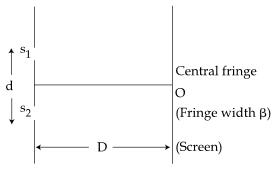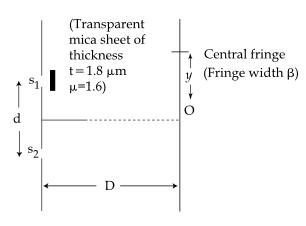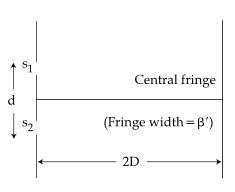Ydse With Thin Slab MCQ - Practice Questions with Answers
Quick Facts
-
YDSE with thin slab is considered one of the most asked concept.
-
7 Questions around this concept.
Solve by difficulty
Using monochromatic light of wavelength $\lambda$, an experimentalist sets up Young's double slit experiment in three ways as shown.
If she observes that $y=\beta^{\prime}$, the wavelength of light used is:



In the figure shown in a YDSE, a parallel beam of light is incident on the slits from a medium of refractive index $n_1$. The wavelength of light in this medium is $\lambda_1$. A transparent slab of thickness ' $t$ ' and refractive index $n_3$ is put in front of one slit. The medium between the screen and the plane of the slits is $n_2$ Find the phase difference between the light waves reaching point ' $O$ ' (symmetrical, relative to the slits)
On introducing a thin mica sheet of thickness and refractive index of 1.5 in the path of one of the waves, central bright maxima shifts by
fringes. The wavelength of the wave used is
, then
is
In Young's double slit experiment, using monochromatic light, the fringe pattern shifts by a certain distance on the screen when a mica sheet of refractive index 1.6 and thickness is introduced in the path of one of the two waves. If now the mica sheet is removed and the distance between the slit and screen is doubled, the distance between successive max. or min. remains unchanged. The wavelength of the monochromatic light used in the experiment is
Monochromatic light of wavelength $5000 \AA$ is incident on two slits separated by a distance of $5 \times 10^{-4} \mathrm{~m}$. The interference pattern is seen on the screen placed at a distance 1 m from the slits. A thin glass plate of thickness $1.5 \times 10^{-6} \mathrm{~m}$ and refractive index of 1.5 is laced between one of the slits and the screen. If intensity in the absence of plate was $I_0$ then new intensity at the center of the screen will be
Concepts Covered - 1
YDSE with thin slab:

Consider the arrangement of Young's double slit experiment as shown in fig. In which a thin
transparent film of refractive index $\mu$ and thickness 't' is introduced in front of the lower slit 'S'. Our aim is to obtain the new position of the net maxima and minima. Let us assume a point $P$ on screen at a distance Y from the origin O . It is important to note that in this particular situation, we cannot calculate the phase difference between the two waves arriving at $P$ directly by calculating the path difference $\left(S_2 P-S_1 P\right)$ because the two waves are not traveling in the same medium. The lower wave travels some distance in a medium $(\mu)$ and the remaining distance in air, while the upper wave travels all the distance in air and traveled in the effective path difference we need to convert the distance traveled in medium $(\mu)$ into its equivalent distance air, which is equal to $(\mu)$ and it is called the optical path. Hence optical path is the equivalent distance to be travels in air to produce the same phase change as that produced in actual in traveling the actual distance. Thus, the optical path difference between the two waves is
$$
\begin{aligned}
& \Delta \mathrm{x}=\left[\left(\mathrm{S}_2 \mathrm{P}-\mathrm{t}\right)+\mu \mathrm{t}\right]-\mathrm{S}_1 \mathrm{P} \text { or } \\
& \Delta \mathrm{x}=\left(\mathrm{S}_2 \mathrm{P}-\mathrm{S}_1 \mathrm{P}\right)+(\mu-1) \mathrm{t} \\
& \text { since } \quad \mathrm{S}_2 \mathrm{P}-\mathrm{S}_1 \mathrm{P}=\mathrm{d} \sin \theta=\mathrm{d}\left(\mathrm{y}^{\prime} / \mathrm{D}\right) \quad \text { (from the fig.) } \\
& \therefore \quad \Delta \mathrm{x}=\mathrm{dy}_{\mathrm{n}}^{\prime} / \mathrm{D}+(\mu-1) \mathrm{t}
\end{aligned}
$$
From the nth maxima,
$$
\Delta \mathrm{x}=\mathrm{n} \lambda, \therefore \mathrm{n} \lambda=\mathrm{dy}_{\mathrm{n}} / \mathrm{D}+(\mu-1) \mathrm{t} \text { or }
$$
$$
y_n=\frac{n \lambda D}{d}-\frac{(\mu-1) t D}{d}
$$
The position of nth maxima and minima has shifted downward by the same distance which is called
$$
\mathrm{S}=\mathrm{y}_{\mathrm{n}}-\mathrm{y}_{\mathrm{n}}^{\prime}=(\mu-1) \frac{\mathrm{tD}}{\mathrm{~d}}
$$
- The distance between two successive maxima or minima remains unchanged. That is, the fringe width remains unchanged by introducing a transparent film.
- The distance of shift is in the direction where the film is introduced. That is, if a film is placed in front of the upper slit the $S_1$, fringe pattern shifts upwards, if a film is placed in front of the lower slit $S_2$, the fringe pattern shifts downward.
Study it with Videos
"Stay in the loop. Receive exam news, study resources, and expert advice!"

